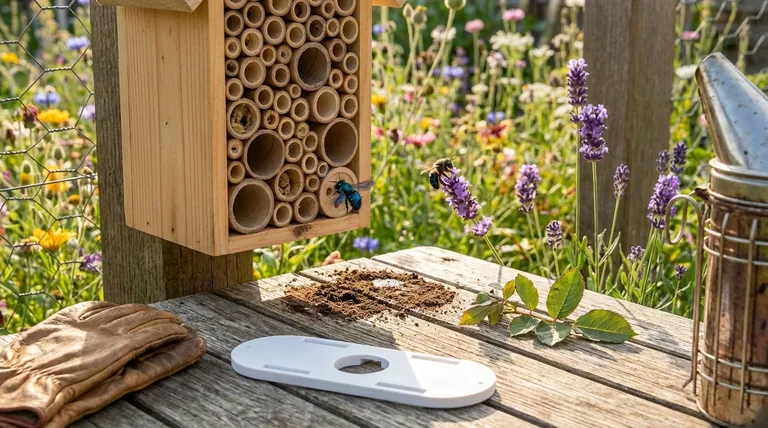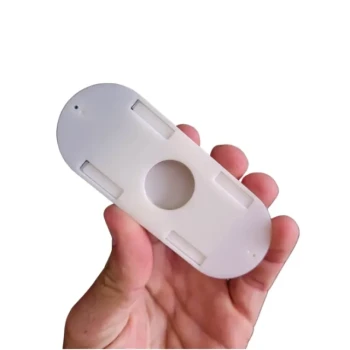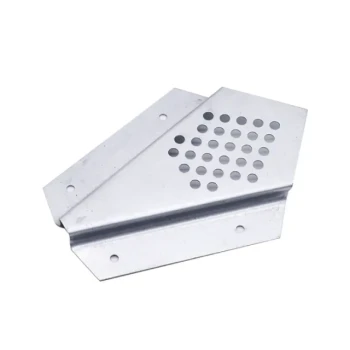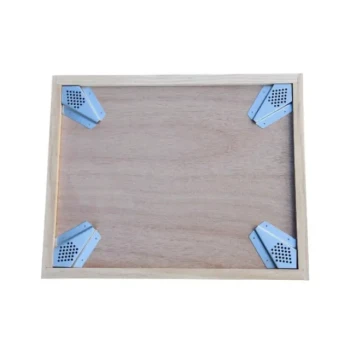To attract bees to a bee house naturally, you must focus on creating the perfect habitat, not on using baits or lures. Success depends entirely on three factors: correct placement of the house, a nearby source of pollen-rich flowers, and the right building materials for your target bees. Common advice to use sugar water is a myth that attracts pests and is ineffective for the bees you want to host.
The core mistake is treating a bee house like a bird feeder. Bee houses are not for feeding, but for nesting. They are designed for solitary bees like mason and leafcutter bees, not honeybees, so success comes from providing the ideal nesting environment they are actively searching for, not from trying to lure them with food.

Understanding Your Target Tenant: Solitary Bees
To attract the right bees, you must first understand who they are and what they need. Bee houses are not for the familiar honeybee or bumblebee, which live in social colonies.
They are for Solitary Nesters
Your bee house is designed to attract solitary bees, such as the gentle mason bee and the resourceful leafcutter bee.
These bees are not aggressive as they do not have a hive to defend. They are extremely efficient pollinators, and their entire goal is to find a safe, secure tunnel to lay their eggs, provision each one with pollen, and seal the chamber.
What Solitary Bees are Searching For
A female solitary bee is looking for a very specific set of conditions. She needs a home that is warm, dry, protected from predators, and, most importantly, located very close to her food source. She will not travel far.
The Critical Flaw of Using Baits
Using sugar water or honey is counterproductive and harmful. These sweet substances attract honeybees, wasps, and ants, which can predate or compete with the solitary bees you want to help.
Furthermore, these solutions do not meet the nutritional needs of solitary bees, who require pollen to provision their young. Offering sugar only creates problems and fails to attract the correct species.
Creating the Ideal Bee House Environment
Your bee house is real estate. To get a tenant, you need to offer the best property in the neighborhood.
Location, Location, Location
The single most important factor is placement. The house should be mounted securely to a wall or post, facing the morning sun (south or southeast).
This early sun warms the bees, giving them the energy to start foraging earlier in the day. The location must also be protected from heavy wind and rain.
Proximity to Food is Non-Negotiable
Solitary bees have a limited flight range, typically around 300 feet (100 meters). If there isn't a significant source of pollen and nectar within that radius, they will not move in.
Plant a variety of native, pollen-rich flowers that bloom throughout the spring and summer. Simple, single-petal flowers are often best.
Provide Essential Building Materials
Different bees use different materials to seal their nesting chambers.
- Mason bees require a source of moist, clay-rich mud. A small patch of bare, damp soil nearby is a perfect offering.
- Leafcutter bees need access to plants with soft, pliable leaves, like roses or lilac, from which they cut perfect circles to build their nests.
Common Pitfalls and Misconceptions
Avoiding common mistakes is as important as following the right steps. Many well-intentioned bee enthusiasts fail because of a few simple oversights.
The Lure of Commercial Attractants
While some pheromone lures exist for mason bees, they are not a magic solution. They can help bees notice a new house, but they cannot overcome a poor location or a lack of food. A perfect habitat is always more effective than an artificial lure.
The Danger of Poor House Design
Not all bee houses are created equal. Avoid houses with tubes made of bamboo that can trap moisture and grow mold. Ensure the tubes are at least 6 inches (15 cm) deep, as shorter tubes result in more male eggs and a less viable population. Houses must also be easy to clean or have replaceable tubes to prevent the buildup of deadly mites and disease.
Misunderstanding the Bee's Purpose
Remember, the bee is not looking for a free meal. A female solitary bee is looking for a safe nursery for her offspring. Your entire strategy should be based on providing that safe, well-stocked nursery environment.
How to Ensure Your Bee House Succeeds
Tailor your approach based on your specific situation to maximize your chances of attracting these beneficial pollinators.
- If you are setting up a new house: Focus entirely on location (morning sun) and planting a diverse patch of native flowers within a short flight path.
- If your current house remains empty: Perform an audit. Is it getting enough sun? Are there flowers close enough? Is there a source of mud or suitable leaves nearby?
- If you want to guarantee success: Purchase a small batch of mason bee cocoons to "seed" your house in the spring. Once they emerge, they will often return to the same location to lay their own eggs.
By creating the right habitat, you provide a genuine sanctuary that solitary bees will naturally find and thrive in.
Summary Table:
| Key Factor for Success | Why It Matters |
|---|---|
| Location (Morning Sun) | Warms bees for early foraging; must be protected from wind/rain. |
| Proximity to Food Source | Solitary bees only forage within ~300 feet; native flowers are essential. |
| Building Materials | Mason bees need mud; leafcutter bees need soft leaves (e.g., roses). |
| Avoid Baits (Sugar Water) | Attracts pests and wrong bee species; does not meet solitary bees' needs. |
Ready to support your local pollinators with the right equipment?
At HONESTBEE, we supply commercial apiaries and beekeeping equipment distributors with high-quality, durable supplies designed for success. Whether you're managing a large-scale operation or stocking your store, our wholesale-focused solutions help you create ideal habitats for solitary bees and other pollinators.
Contact our expert team today to discuss your specific needs and discover how our products can enhance your beekeeping success.
Visual Guide

Related Products
- Professional Durable Two-Piece Plastic Bee Escape
- Multi-Functional Sliding Hive Entrance for Beekeeping
- Food Grade Plastic bee Foundation for Bee Frames
- Heavy Duty Metal Corner Bee Escape for Reliable Hive Clearing
- Professional Galvanized Hive Strap with Secure Locking Buckle for Beekeeping
People Also Ask
- How can bees be cleared off honey supers in a Langstroth hive? Use a Gentle Bee Escape
- What is the method of separating bees from honey supers using the Bee Escape Board? A Gentle, Low-Stress Harvesting Guide
- What is a bee escape and why is it used in beekeeping? A Guide to Gentle Honey Harvesting
- What is a bee escape board and how does it help in harvesting honey? A Gentle, Chemical-Free Harvesting Solution
- What is the purpose of a bee escape board? A Gentle, Chemical-Free Way to Harvest Honey






